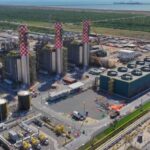Energy News Beat
ENB Pub Note: What is Brazil’s energy mix, you might ask, so we included above the update from LNGPime.com. We are seeing LNG to power plant model being a great solution for coastal countries wanting low-carbon solutions.
-
Hydropower: 57.5% – The backbone of Brazil’s grid, leveraging extensive river systems like the Amazon and Paraná, with major plants like Itaipu and Belo Monte.
-
Wind: 13.9% – Rapidly expanding, especially in the Northeast, with 22 GW of installed capacity by 2022.
-
Solar: 9% – Growing significantly, with over 30 GW of installed capacity in 2023, driven by utility-scale and distributed projects.
-
Biofuels/Biomass: 6.8% – Includes sugarcane bagasse and other biomass, contributing to both electricity and transport fuels.
-
Natural Gas: 7.1% – Used mainly as a backup during low hydropower output, with 34 gas-fired plants totaling 11 GW.
-
Nuclear: 2.1% – Two reactors (Angra 1 and 2) provide a small but stable baseload, with a third under construction.
-
Coal: 1.9% – Minimal and targeted for phase-out by 2040 under Brazil’s climate commitments.
-
Oil: 1.5% – Marginal, used in some thermal plants.
-
Unspecified Fossil Fuels: 0.2% – Negligible contribution.
-
Petroleum and Other Liquids: ~34.3% – Dominant in transport and industry, with Brazil producing 3.3 million barrels per day, 76% from pre-salt offshore fields.
-
Renewables (including Hydro): ~45% – Includes hydropower (12.4%), sugarcane ethanol (18%), and other renewables (7%). Brazil is the world’s second-largest ethanol producer.
-
Natural Gas: ~12.2% – Growing due to offshore reserves, representing 7% of energy production.
-
Firewood and Charcoal: ~8.8% – Used in rural areas and some industries.
-
Coal: ~5.3% – Limited to specific industrial applications.
-
Nuclear: ~1.4% – Small but consistent contribution.
-
Other Non-Renewables: ~0.6% – Minor sources.
Key Characteristics and Trends
-
Renewable Dominance: Brazil’s electricity matrix is among the cleanest globally, with 83–93% renewable generation (depending on the year and source). This contrasts with the global average of ~25%.
-
Hydropower Challenges: While hydropower remains central, its expansion is limited by environmental concerns and remote locations. Run-of-river plants are increasingly favored to reduce ecological impact.
-
Solar and Wind Growth: Solar and wind are the fastest-growing sources, with solar expected to rival wind investments by 2030. Offshore wind projects are also emerging.
-
Biofuels Leadership: Brazil is a global leader in ethanol, with over 50% of light vehicle fuel demand met by sugarcane ethanol, supported by flex-fuel vehicles.
-
Fossil Fuel Role: Fossil fuels, particularly oil and gas, are critical for transport and industry but are declining in electricity generation. Brazil aims to phase out coal by 2040 and achieve net-zero emissions by 2050.
-
Energy Security: Brazil’s high renewable share and domestic oil/gas production reduce reliance on imports, though droughts can strain hydropower, increasing gas use.
Future Outlook
Source: LNGPrime.com
GNA is a venture consisting of UK’s energy giant BP, Germany’s engineer Siemens, China’s SPIC, and Prumo. The Brazilian private company is controlled by US-based EIG Global Energy Partners.
According to a statement by GNA, Brazil’s power regulator Aneel approved the start of commercial operations at the GNA II power plant.
In September 2021, GNA commissioned the first 1.3-gigawatt LNG power plant.
The JV officially launched construction work on the second plant in February 2022.
Siemens Energy secured a contract to build the second LNG power plant for GNA.
The company announced in November 2021 that the contract was valued at approximately 1 billion euros ($1.14 billion).
The scope for Siemens included the entire power island delivery, which consisted of three highly efficient HL class gas turbines, one steam turbine, four electric generators, and three heat recovery steam generators.
Also, Siemens built the power plant together with the consortium partner Andrade Gutierrez who provided the civil works, the infrastructure, and the erection works.
Combined, these two power plants have 3 GW of installed capacity, forming the largest gas-to-power project in Latin America, GNA claims.
Besides the power plants, the complex includes an LNG terminal with a total capacity of 21 million cubic meters per day.
FSRU BW Magna arrived in June 2020 in the Brazilian port to start its contract serving GNA’s project. After that, BP supplied the first-ever cargo to BW’s FSRU in December 2020.
The post Brazil’s GNA launches second LNG power plant appeared first on Energy News Beat.









